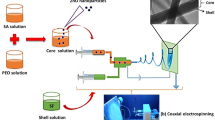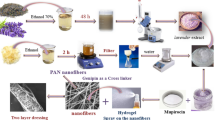Abstract
The non-woven wound dressing with core–shell structured fibers was prepared by coaxial electrospinning. The polycaprolactone (PCL) was electrospun as the fiber’s core to provide mechanical strength whereas collagen was fabricated into the shell in order to utilize its good biocompatibility. Simultaneously, the silver nanoparticles (Ag-NPs) as anti-bacterial agent were loaded in the shell whereas the vitamin A palmitate (VA) as healing-promoting drug was encapsulated in the core. Resulting from the fiber’s core–shell structure, the VA released from the core and Ag-NPs present in the shell can endow the dressing both heal-promoting and anti-bacteria ability simultaneously, which can greatly enhance the dressing’s clinical therapeutic effect. The dressing can maintain high swelling ratio of 190% for 3 d indicating its potential application as wet dressing. Furthermore, the dressing’s anti-bacteria ability against Staphylococcus aureus was proved by in vitro anti-bacteria test. The in vitro drug release test showed the sustainable release of VA within 72 h, while the cell attachment showed L929 cells can well attach on the dressing indicating its good biocompatibility. In conclusion, the fabricated nanofibrous dressing possesses multiple functions to benefit wound healing and shows promising potential for clinical application.
Similar content being viewed by others
References
Mogoşanu G D, Grumezescu A M. Natural and synthetic polymers for wounds and burns dressing. International Journal of Pharmaceutics, 2014, 463(2): 127–136
Boateng J S, Matthews K H, Stevens H N E, et al. Wound healing dressings and drug delivery systems: a review. Journal of Pharmaceutical Sciences, 2008, 97(8): 2892–2923
Winter G D. Formation of the scab and the rate of epithelization of superficial wounds in the skin of the young domestic pig. Nature, 1962, 193(4812): 293–294
Zahedi P, Rezaeian I, Ranaei-Siadat S O, et al. A review on wound dressings with an emphasis on electrospun nanofibrous polymeric bandages. Polymers for Advanced Technologies, 2010, 21: 77–95
Jiang H, Hu Y, Zhao P, et al. Modulation of protein release from biodegradable core–shell structured fibers prepared by coaxial electrospinning. Journal of Biomedical Materials Research Part B: Applied Biomaterials, 2006, 79B(1): 50–57
Shao W, He J, Sang F, et al. Coaxial electrospun aligned tussah silk fibroin nanostructured fiber scaffolds embedded with hydroxyapatite-tussah silk fibroin nanoparticles for bone tissue engineering. Materials Science and Engineering C, 2016, 58(C): 342–351
Agarwal S, Wendorff J H, Greiner A. Use of electrospinning technique for biomedical applications. Polymer, 2008, 49(26): 5603–5621
Liang D, Hsiao B S, Chu B. Functional electrospun nanofibrous scaffolds for biomedical applications. Advanced Drug Delivery Reviews, 2007, 59(14): 1392–1412
Wu H, Hu L, Rowell M W, et al. Electrospun metal nanofiber webs as high-performance transparent electrode. Nano Letters, 2010, 10(10): 4242–4248
Sridhar R, Lakshminarayanan R, Madhaiyan K, et al. Electrosprayed nanoparticles and electrospun nanofibers based on natural materials: applications in tissue regeneration, drug delivery and pharmaceuticals. Chemical Society Reviews, 2015, 44(3): 790–814
Wang R, Liu Y, Li B, et al. Electrospunnanofibrous membranes for high flux microfiltration. Journal of Membrane Science, 2012, 392–393: 167–174
Martinez-Sanz M, Lopez-Rubio A, Villano M, et al. Production of bacterial nanobiocomposites of polyhydroxyalkanoates derived from waste and bacterial nanocellulose by the electrospinning enabling melt compounding method. Journal of Applied Polymer Science, 2016, 133(2): 42486
Li Z, Zhang H, Zheng W, et al. Highly sensitive and stable humidity nanosensors based on LiCl doped TiO2 electrospun nanofibers. Journal of the American Chemical Society, 2008, 130 (15): 5036–5037
Holmes B, Fang X, Zarate A, et al. Enhanced human bone marrow mesenchymal stem cell chondrogenic differentiation in electrospun constructs with carbon nanomaterials. Carbon, 2016, 97: 1–13
Sun Z, Zussman E, Yarin A L, et al. Compound core–shell polymer nanofibers by Co-electrospinning. Advanced Materials, 2003, 15(22): 1929–1932
Hu X, Liu S, Zhou G, et al. Electrospinning of polymeric nanofibers for drug delivery applications. Journal of Controlled Release, 2014, 185(C): 12–21
Yarin A L. Coaxial electrospinning and emulsion electrospinning of core-shell fibers. Polymers for Advanced Technologies, 2011, 22(3): 310–317
Li H, Zhao C, Wang Z, et al. Controlled release of PDGF-bb by coaxial electrospun dextran/poly(L-lactide-co-ε-caprolactone) fibers with an ultrafine core/shell structure. Journal of Biomaterials Science. Polymer Edition, 2010, 21(6–7): 803–819
Jia X, Zhao C, Li P, et al. Sustained release of VEGF by coaxial electrospun dextran/PLGA fibrous membranes in vascular tissue engineering. Journal of Biomaterials Science. Polymer Edition, 2011, 22(13): 1811–1827
Rho K S, Jeong L, Lee G, et al. Electrospinning of collagen nanofibers: effects on the behavior of normal human keratinocytes and early-stage wound healing. Biomaterials, 2006, 27(8): 1452–1461
Chattopadhyay S, Raines R T. Review collagen-based biomaterials for wound healing. Biopolymers, 2014, 101(8): 821–833
Han J, Lazarovici P, Pomerantz C, et al. Co-electrospun blends of PLGA, gelatin, and elastin as potential nonthrombogenic scaffolds for vascular tissue engineering. Biomacromolecules, 2011, 12(2): 399–408
Zeugolis D I, Khew S T, Yew E S Y, et al. Electro-spinning of pure collagen nano-fibres–just an expensive way to make gelatin? Biomaterials, 2008, 29(15): 2293–2305
Abdelgawad A M, Hudson S M, Rojas O J. Antimicrobial wound dressing nanofiber mats from multicomponent (chitosan/silver-NPs/polyvinyl alcohol) systems. Carbohydrate Polymers, 2014, 100: 166–178
Wu J, Zheng Y, Song W, et al. In situ synthesis of silvernanoparticles/ bacterial cellulose composites for slow-released antimicrobial wound dressing. Carbohydrate Polymers, 2014, 102(4): 762–771
Martins N C T, Freire C S R, Pinto R J B, et al. Electrostatic assembly of Ag nanoparticles onto nanofibrillated cellulose for antibacteria paper products. Cellulose, 2012, 19(4): 1425–1436
Hartong D T, Berson E L, Dryja T P. Retinitis pigmentosa. Lancet, 2006, 368(9549): 1795–1809
Leonardi G R, Campos P MB G M. Influence of glycolic acid as a component of different formulations on skin penetration by vitamin A palmitate. Journal of Cosmetic Science, 1998, 49(1): 23–32
Sun B, Duan B, Yuan X. Preparation of core/shell PVP/PLA ultrafine fibers by coaxial electrospinning. Journal of Applied Polymer Science, 2006, 102(1): 39–45
Liao I C, Chew S Y, Leong K W. Aligned core–shell nanofibers delivering bioactive proteins. Nanomedicine, 2006, 1(4): 465–471
Catledge S A, Clem W C, Shrikishen N, et al. An electrospun triphasic nanofibrous scaffold for bone tissue engineering. Biomedical Materials, 2007, 2(2): 142–150
Chang M C, Tanaka J. FT-IR study for hydroxyapatite/collagen nanocomposite cross-linked by glutaraldehyde. Biomaterials, 2002, 23(24): 4811–4818
Pezeshki A, Ghanbarzadeh B, Mohammadi M, et al. Encapsulation of vitamin A palmitate in nanostructured lipid carrier (NLC)- effect of surfactant concentration on the formulation properties. Advanced Pharmaceutical Bulletin, 2014, 4(6): 563–568
Choi J S, Lee S J, Christ G J, et al. The influence of electrospun aligned poly(ε-caprolactone)/collagen nanofiber meshes on the formation of self-aligned skeletal muscle myotubes. Biomaterials, 2008, 29(19): 2899–2906
Bedran-Russo A K B, Pereira P N R, Duarte W R, et al. Application of crosslinkers to dentin collagen enhances the ultimate tensile strength. Journal of Biomedical Materials Research Part B: Applied Biomaterials, 2007, 80B(1): 268–272
Gümüşderelioğlu M, Dalkıranoğlu S, Aydın R S T, et al. A novel dermal substitute based on biofunctionalized electrospun PCL nanofibrous matrix. Journal of Biomedical Materials Research Part A, 2011, 98A(3): 461–472
Nguyen T H, Kim Y H, Song H Y, et al. Nano Ag loaded PVA nano-fibrous mats for skin applications. Journal of Biomedical Materials Research Part B: Applied Biomaterials, 2011, 96B(2): 225–233
Singh N, Khanna P K. In situ synthesis of silver nano-particles in polymethylmethacrylate. Materials Chemistry and Physics, 2007, 104(2–3): 367–372
Duell E A, Kang S, Voorhees J J. Unoccluded retinol penetrates human skin in vivo more effectively than unoccluded retinyl palmitate or retinoic acid. The Journal of Investigative Dermatology, 1997, 109(3): 301–305
Author information
Authors and Affiliations
Corresponding author
Additional information
Q.W. and F.X. contributed equally to this work.
Rights and permissions
About this article
Cite this article
Wei, Q., Xu, F., Xu, X. et al. The multifunctional wound dressing with core–shell structured fibers prepared by coaxial electrospinning. Front. Mater. Sci. 10, 113–121 (2016). https://doi.org/10.1007/s11706-016-0339-7
Received:
Accepted:
Published:
Issue Date:
DOI: https://doi.org/10.1007/s11706-016-0339-7




